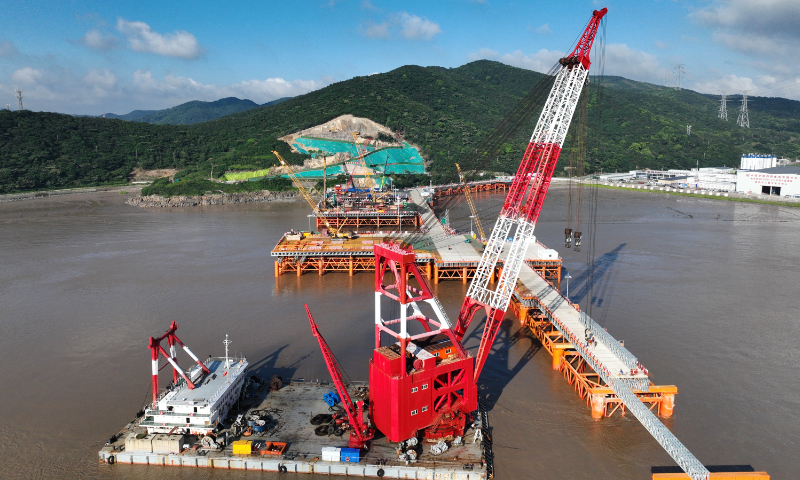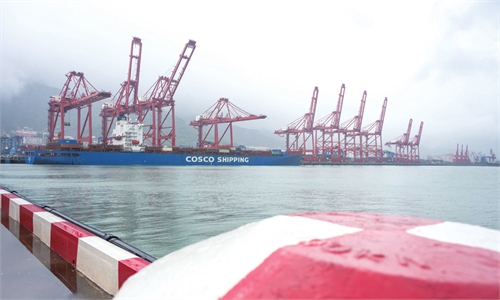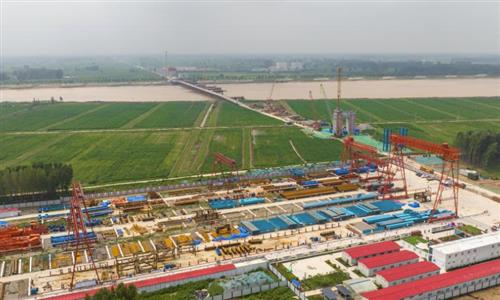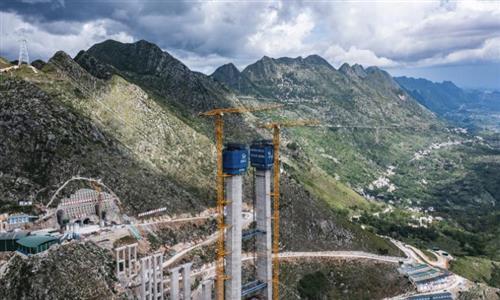Construction begins on the world's longest-span railway-highway dual-use bridge in Zhoushan

Construction of the Xihoumen railway-highway dual-use bridge, a key project of the Ningbo-Zhoushan Railway, is ongoing in Zhoushan, East China's Zhejiang Province on August 6, 2023. Photo: VCG
The underwater construction of the main tower of the Xihoumen railway-highway dual-use bridge, a key project of the Ningbo-Zhoushan Railway, has recently started. It will be the world's largest highway and railway bridge with the longest span. The completion of the bridge will enable Zhoushan to connect to the national railway network, as reported by China Media Group (CMG) on Sunday.
The Xihoumen Bridge, currently under construction, will span the Xihoumen waterway, connecting Jintang Island and Cezi Island of the Zhoushan archipelago in East China's Zhejiang Province.
Currently, the main pier foundation of the bridge is fully underway, and girder construction is expected to start in 2025. The challenges of strong wind, high waves, deep sea, and swift rapids have increased the construction's difficulty, according to CMG.
The Xihoumen waterway, where the Xihoumen railway-highway dual-use bridge is located, serves as a prime sea passage for accessing the Ningbo-Zhoushan Port. More than 200 30,000-ton container ships and various bulk cargo ships navigate this waterway daily.
Due to anticipated higher navigation demands and the complex topography and geology of the sea, the bridge's main span extends 1,488 meters, marking it as the highway and railway bridge with the world's longest span currently.
The bridge has a total length of 3,118 meters. Both the railway and the highway sections of the bridge will be on the same level: a double-line railway for passengers in the center, designed for speeds of up to 250 kilometers per hour, flanked on both sides by a two-way six-lane highway with a design speed of 100 kilometers per hour.
With a width of 68 meters, this bridge also claims the title of the world's widest sea bridge.
The bridge plays an essential role in the Ningbo-Zhoushan Railway, whose construction commenced in November 2022. This railway will establish a connection between Zhejiang's Ningbo and the islands of Zhoushan.
Designed with seven stations and a speed of 250 kilometers per hour, the construction phase is slated for six years. The expectation is that the railway will be operational by 2028. By that time, Zhoushan, the sole city in the Yangtze River Delta presently without railway access, will be integrated into the national railway network. Consequently, the travel duration from Ningbo to Zhoushan will reduce to approximately 26 minutes, and from Hangzhou to Zhoushan, it will be about an hour once the railway is functional.
The forthcoming Ningbo-Zhoushan Railway line will stretch over 70.1 kilometers, incorporating 36 bridges and 17 tunnels.
Apart from the Xihoumen railway-highway dual-use bridge, the Jintang tunnel, boasting a length of 16.18 kilometers, is set to be the world's longest submarine high-speed railway tunnel. Preliminary construction is currently in progress for the tunnel.
For ensuring train safety, the tunnel's diameter must be no less than 14.57 meters, equivalent to a five-story building's height. Consequently, the builders, subsidiaries of the China Railway Group, have pioneered an ultra-large diameter shield machine.
By May 2024, this shield machine will commence its seabed excavation, with the aspiration that the undersea tunnel will see completion by 2027. Without the innovative shield machine, constructing a tunnel through such intricate geological layers, buried up to 78 meters beneath the sea, would typically take no less than 12 years.
Provisions have also been made at the Ma'ao station of the Ningbo-Zhoushan Railway for potential future connectivity to Shanghai. This would reduce travel time from Zhoushan's main city to Shanghai Pudong International Airport from the current 2-hour car journey to approximately 40 minutes via high-speed rail.



